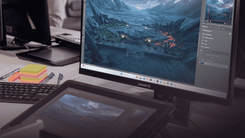Table of Contents
- Risk of Outsourcing
- Set Objectives Early
- Define Ownership and IP Rights Clearly
- Set Up Strong Structures
- Communicate Frequently and Transparently
- Plan for Flexibility (and Exit)
- Final Thoughts
How to Manage the Risks of Game Outsourcing
Learn how to manage outsourcing risks in game development with clear communication, IP protection, and strong collaboration practices.
Security requirements are no stranger to game development. Whether it’s locked-down PCs, NDAs, or strict contracts, studios often have rigorous internal policies in place. But what happens when you bring in an outsourcer?
Hiring an external company can feel risky - you're putting your trust in what may essentially be strangers. What if the partnership fails and you’ve lost precious funding? You know you need the help, but how can you ensure the collaboration runs smoothly while still protecting your studio? Developers must find ways to build trust and effectively manage the risks that come with outsourcing to third-party vendors.
In this article, we’ll explore some of the key risks and share practical strategies to safeguard your project. Drawing on experience working with clients ranging from indie studios - where every resource counts - to AAA developers - where security is paramount - we’ll show you how to get the most out of your external development partners in the gaming industry.
Outsourcing - or external development - is the business practice of a video game developer hiring a third party - known as an outsourcing studio to perform tasks or services such as concept art, 3D asset creation, UI/UX, coding, etc.
Risk of Outsourcing
There are several risks associated with outsourcing, and we’ve identified some of the most significant concerns we've encountered:
- Misaligned goals or expectations
- Intellectual property (IP) disputes
- Unknown progress on tasks
- Communication breakdowns
Set Objectives Early
Misaligned goals or expectations can lead to wasted time and budget on your project. It is important from the offset to have clear communication, as outsourcing studios are often located all over the world, and in-person meetings aren’t always realistic. However, it’s easy and highly beneficial to organize a virtual call to go over the expectations for the project. This meeting should happen well before the project kicks off to ensure there’s enough time to share the right materials, answer any questions, and to get everyone on the same page.
You can use the meeting to share work completed by your team so far, reference images, or art bibles - anything that you think could help guide the outsourcer and give them a clear understanding of your project’s style and direction. A virtual meeting also helps build rapport and set clear expectations. It’s an opportunity to discuss the brief, clarify roles, and confirm that everyone understands the goals.
Make sure you also to define and agree on key deliverables as well as asking what the typical timeline for completing them would be for the team. If you have an internal deadline, communicate it early so your outsourcing team can plan accordingly.
The meeting is also a great opportunity to introduce yourself and your wider team to the external partner, and to meet their team in return. From the outset, it should be clear who is responsible for providing feedback and who the outsourcers will be reporting to, and who is your point of contact from the external developers side.
To further reduce the chance of confusion, it’s helpful to create clear documentation that both your team and the outsourcer can refer to throughout the project. This ensures consistency and minimizes misunderstandings.

Define Ownership and IP Rights Clearly
Intellectual property (IP) rights are incredibly valuable - and it's essential to maintain ownership of them.
You must always have a contract in place between your studio and any external development partner. It’s crucial to consult a lawyer who can help you draft a contract that clearly outlines the transfer of IP rights related to the work being produced. The agreement should define who owns what - before, during, and after the engagement.
You want to ensure that all work created on and for your project by the outsourcer is fully transferred to you, and that you have the necessary rights to use it as needed.
Always seek legal advice when drafting contracts or reviewing those provided by external vendors. Protecting your IP from the outset will save you from potential legal and financial issues down the line.
Set Up Strong Structures
From the very beginning, it’s essential to establish how progress will be tracked and reported. Otherwise, how do you know how the work is going?
There are many ways to handle this but it really comes down to what works best for your team and your outsourcing partner.
You might use instant messaging platforms like Slack or Microsoft Teams to stay in regular contact and share updates. Alternatively, tools like Miro or ShotGrid can be used for submitting work and consolidating feedback in one easily accessible location.
Many outsourcing studios also have dedicated Producers who are responsible for tracking progress and reporting to clients. Relying on them can streamline communication and help keep everything on schedule.
Establishing these systems allows you to monitor progress more effectively. Just as importantly, you need to know who to contact if something isn’t going as expected. Your outsourcer should identify that person early on, and help to make sure that the communication structure is clear from the outset.

Being able to see tangible results, whether those are sketches submitted to Miro, or an update in Slack from your outsourcing team can help you to feel more comfortable knowing that the work is proceeding without issue.
Communicate Frequently and Transparently
Communication is the cornerstone of a successful partnership.
Misunderstandings can lead to serious issues, ranging from poor quality and missed deadlines to unexpected costs.
You can help minimize communication problems right from the start by ensuring your outsourcer communicates clearly during the initial contact. Setting up regular check-ins is also essential. These meetings provide a great opportunity to give feedback, track progress, and realign the team if needed.
Shared tools and platforms like Miro or ShotGrid are useful for reviewing work collaboratively, while real-time messaging tools such as Slack or Microsoft Teams make day-to-day communication faster and more seamless.
It’s also important to foster an open, honest, and encouraging feedback culture on both sides. You should feel comfortable giving constructive feedback, and your outsourcing partner should feel equally confident asking questions when they need clarification.
In fact, questions from your outsourcer are a good thing, it shows engagement and a proactiveness to help clear up misunderstandings before they happen.
Plan for Flexibility (and Exit)
The reality is that not all partnerships work out.
Sometimes it’s simply the wrong project, or a mismatch in culture, communication, or working practices. There are many reasons a collaboration might not be the right fit - and that’s okay.
To help reduce long-term risk, consider building flexibility into your briefs and task assignments. For example, you could start with a small task that is almost a kind of ‘test brief’ before committing to a larger scope of work. This gives you a chance to assess how well the team fits your needs without a long-term commitment.
Project extensions are common in external development, so a good outsourcing partner will understand and accommodate this kind of phased approach.
It is also important that your contract includes a clear exit clause for both parties. Everyone should be aligned on what happens if the partnership ends. Will files need to be returned? Should access to tools like Slack or email be revoked? Is there a requirement to delete project-related materials? These details should be clearly defined from the outset.
Final Thoughts
Outsourcing can be an incredibly effective way to scale your game development efforts, bringing in specialized skills, extending your team’s capacity, and helping you meet goals. But like any partnership, it comes with its own set of risks and challenges.
By establishing clear communication, aligning on expectations early, securing your intellectual property, and building flexible structures, you set the foundation for a smooth and productive collaboration. And if things don’t go as planned, having well-defined exit terms and processes in place ensures that both parties can part ways respectfully and professionally.
Ultimately, successful outsourcing is built on mutual trust, transparency, and preparation. When managed well, it can be a powerful extension of your team and a valuable asset to your project’s success.
At Athena Productions, we understand the challenges of outsourcing because we’ve been trusted partners to studios of all sizes - from indie teams to AAA developers. Our experienced concept art and visual development team is built around clear communication, secure workflows, and flexible collaboration, making us a reliable extension of your in-house team. Get in touch today!



